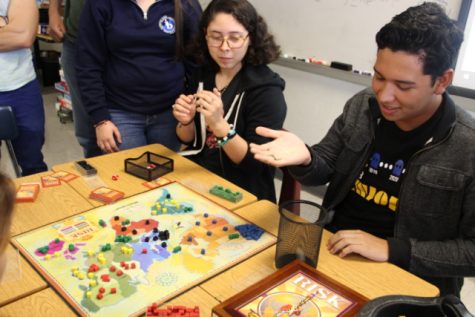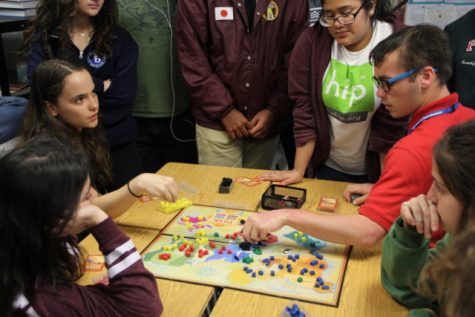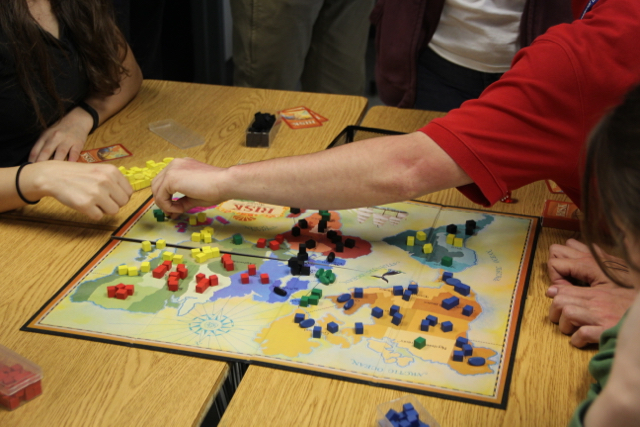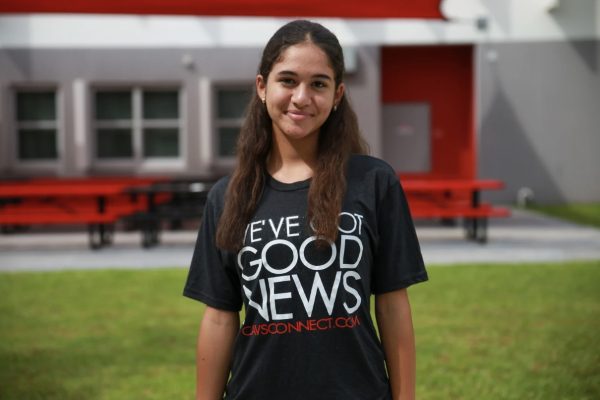Games for Grades? Alternative Teaching Methods at Gables
Students play board games as an interactive way to learn history.
Feb 20, 2018
Teaching as a profession has been honored in the eyes of the general public, seen as one of the most crucial roles in the development of future generations. Teachers, apart from undergoing rigorous academic training, often shadow existing teachers to learn how to teach students using creative and atypical methods. At Gables, several teachers have taken alternative teaching methods and embedded them into their lesson plans, creating an interesting and engaging learning environment for students.

Students engage in a game of RISK! to learn the motives behind world domination as displayed in World War 2.
Among these teachers is Mr. De Armas, who teaches IB Standard and Higher Level Contemporary History. As in any other history class, armed conflicts are investigated with great detail, highlighting how they developed and impacted wider society. However, seeing as conflicts often have hidden tactics and motivations and teaching them in a conventional way can cause a great deal of confusion, Mr. De Armas uses the popular board game Risk to help students gauge these motivations and tactics from a first person perspective. The game, in essence, is a test of strategy, giving each player a certain amount of troops and requiring them to advance into the territories of other players. As the game progresses and certain players advance, other players are eliminated until one player remains. In addition, Mr. De Armas also frames each game around the particular era being studied in class.
“I can not tell you the amount of times I laughed while playing this game, I never thought a board game would help me understand history so much,” junior Adriana Castro said.

Students strategically decide their next move.
Mr. De Armas is not the only teacher using innovative ways to run his classroom. Ms. Zaldivar, another ingenious teacher, pushes the boundaries of traditional instruction in an equally engaging manner. Ms. Zaldivar is an AP
English Literature and Composition teacher and the sponsor for Catharsis, the school’s literary magazine. Given her background with such a creative publication, it is no surprise that her creativity flows over into her everyday teaching. Students often think of English as a subject dominated by long books and countless essays, but Ms. Zaldivar has implemented the “Fishbowl” method, a teaching strategy wherein the students are organized in a circle with the exception of six who are in the middle. Those six students are randomly picked and then told to discuss a prompt that was presented to them at the beginning of class. Each person in the middle or “the fishbowl” must use evidence from the text being discussed to support their argument. The students outside the fishbowl give feedback to those in the middle followed by an overall discussion. This method has obligated students to take a deeper look into the literature at hand and discuss it from different points of view, substituting the conventional lecture style common in English classes.
“It is remarkably useful for writing our essays and betters our overall understanding of the text being studied in class,” junior Paola Gonzalez said.
The profession of education has made a substantial evolution from its humble beginnings in the homes of individual families to large public schools seen today. With such a radical evolution in teaching styles has come a change in the way students learn. This change has no doubt been for the better, allowing students to receive a truly world class education all while having fun.












